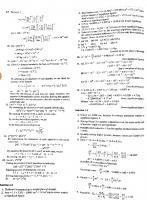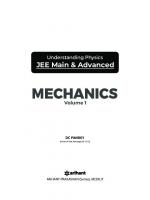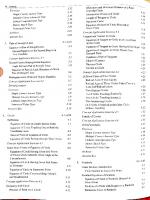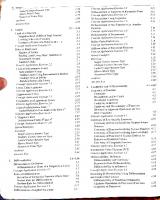Mechanics II for JEE (Advanced) [3 ed.] 9353503744, 9789353503741
3,373 826 279MB
English Pages [428] Year 2019
Recommend Papers
![Mechanics II for JEE (Advanced) [3 ed.]
9353503744, 9789353503741](https://ebin.pub/img/200x200/mechanics-ii-for-jee-advanced-3nbsped-9353503744-9789353503741.jpg)
- Author / Uploaded
- B. M. Sharma
File loading please wait...
Citation preview
Contents
ix
Preface 1.
System
1.1 Particles
1.1
Continuous Mass Distribution
Centre of Mass of a Centre of Mass of a Uniform Rod
1.2
Centre of Mass of Semicircular Ring
1.3 1.3 1.5
Centre of Mass of a
System ofN Discrete
Concept
1.6
Systems of Many Particles of a System Displacement of Centre of Mass
1.10 1.14
Concept Application Exercise 1.2 Conservation of Linear Momentum for System
1.15
of Particles
Mechanical
Energy
1.19
Exercise 1.3
Energy of a System of Particles
and Non-Conservative Force
Centre of Mass Frame of Reference
or
Linear Momentum of Two Particles to Centre of Mass Frame
Relative
Particles Energy of a System of of Particles Work-Energy Theorem for a System
to Centre of Mass
Centroidal Frame Total Work of Pseudo Forces in Exercise 1.4
Concept Application Solved Examples Exercises
1.20 1.21
System
2.7 2.8 2.9
Coefficient of Restitution (e)
2.12 2.13 2.15 2.15
Exercise 2.2
Concept Application Direct Impact General Equation for 2.3
Exercise Concept Application (Oblique Impact) Collision in Two
Dimensions
2.17
2.18
Two Discs
Oblique Collision of Collision of Wedge and Concept Application
2.19
Particle
2.2 2.21 2.2
Exercise 2.4
Variable Mass System Rocket Propulsion
Concept Application Exercise
2.23
2.5
24
Solved Examples
Kinetic
Energy Theorem Relative
1.20
Centroidal
Frame
2.1
Impact Parameter
of Particles
Gravitational Potential
Exercise
Collision or Impact
1.3
Centre of Mass of a Application Exercise 1.1
Concept Application
Concept Application
Types o f Collision
Semicircular Disc
2.32
Exercises Single Correct Answer Type
2.32
1.21 1.21
Multiple Correct Answers Type
2.37
Linked Comprehension Type
2..40
1.23
Matrix Match Type
2.44
Numerical Value Type
2.46
1.23 1.23 1.25
2.48 2.50
Archives Answers Key
1.27
1.35
3. Rigid Body Dynamics: Part 1
3.1-3.57
1.35
Introduction
3.1
Multiple Correct Answers Type
1.41
Rigid Body
3.1
Linked Comprehension Type Matrix Match Type
1.44 1.46
Numerical Value Type
1.49
Single Correct Answer Type
Archives
Answers Key 2.
2.7
Impulsive Force
1.1-1.52
of Particles and Centre of Mass
Centre of Mass
Work
2.1 2.2
Instantaneous Impulse
Impulse and Collision Introduction
Impulse
1.51 1.52
General Rigid Body Motion Relative Angular Velocity in Case of a Rigid Body Types of Rotational Motion Rotation About a Fixed Axis or Pure Rotation
Combined Rotation and Translation 2.1-2.50 2.1 2.1
Concept Application Exercise 3.1
Instantaneous Axis of Rotation Finding Instantaneous Axis of Rotation in DifYerent Situationss
3.1
3.2 3.3 3.3 3.3 3.5 3.5
3.6
iv
Contents
3.7
Rolling Motion
3.8
Rolling as Pure Rotation About Point of Contact
3.8 3.8
Translation Combined Constraints Due to Ropes and Pulleys Constraints on a Rod Having Combined Translational
3.9
Concept Application Exercise 3.2
3.10
Moment of Inertia Moment of Inertia of a Rigid Body
3.10 3.11 3.11
Moment of Inertia ofa Circular Ring About an Axis
Passing Through
Its Centre and
Perpendicular
Momentum of a
4.4
Rigid Body
Due to
Translation and Rotation Both
4.4
Exrercise 4.1
4.6
Concept Application
Angular Impulse: Impulse-Momentum Theorem
Law of Conservation of Angular Momentum Concept Application Exercise 4.2
Applying Torque Equation About Instantaneous 4.13
Concept Application Exercise 4.3
4.14
Dynamics of Rolling Motion
4.15
Rolling of an Object Without Net
to 3.12
4.6 4.6 4.10
Dynamics of Combination of Translation and Rotation 4.10 Centre of Rotation (ICR)
Moment of Inertia ofa Straight Rod About an Axis
Through Its Centre
About a Fixed Axis of Rotation
Angular
Constraint Relations in Case of Rotation and
and Rotational Motion
Angular Momentum of a Rotating Rigid Object
External Force
4.15
Concept Application Exercise 4.4
4.17 4.22
MI of a Triangular Lamina About Its Base
3.12
Kinetic Energy of Rotating Body About a Fixed Axis
4.23
MI of a Square Lamina About Its Diagonal
3.12 3.13
Kinetic Energy of a Body in Combined Rotation
and Translation
Perpendicular Axis Theorem
3.13
Kinetic Energy of a Body Rolling on a Fixed
Parallel Axis Theorem
3.14
Surface
Its Plane
12
Moment of Inertia of a Disc
Moment of Inertia About a General Axis of Rotation
Rolling of an Object Under Net External Force
Rotational Work and Power
4.23 4.25
4.26
Radius of Gyration
3.15
Mass Distribution and Moment of Inertia
3.15
Work-Kinetic Energy Theorem for Rotational
3.17
Motion
4.27
Conservation of Mechanical Energy
4.28
Concept Application Exercise 3.3
Torque
3.18
4.32 4.33
Calculation of Torque
3.19
Concept Application Exercise 4.5
Couple
3.20
Rolling ofa Body on an Inclined Plane
Equilibrium of Rigid Bodies
3.20
Concept Application Exercise 3.4
3.23
Toppling and Shifting of Normal Reaction
3.24
Concept Application Exercise 3.5 Newton's Second Law for Rotational Motion Concept Application Exercise 3.6 Solved Examples
3.26
Application of Conservation of Mechanical Energy 4.33 for Finding the Acceleration of Rolling Object Application of Angular Momentum Principle for 4.33 Finding the Acceleration of Rolling Object 4.35 Concept Application Exercise 4.6
Exercises Single Correct Answer Type
Multiple Correct Answers Type Linked Comprehension Type
3.27 3.30
3.31 3.36 3.36 3.43
Angular Impulse Calculation of Angular Impulse
4.36
4.36
Conservation of Angular Momentum in Case of 4.38 Collision of Rigid Bodies Case 1: Collision of a Rigid Body with a Fixed Surface 4.38 Case 2: Collision of a Particle with Rigid Body with the Axis of Rotation is Fixed
4.39
3.51
Case 3: Collision of a Particle with Rigid Body When the Body is Free to Rotate as Well as Translate
4.40
Archives
3.53
Concept Application Erercise 4.7
4.42
Answers Key
3.56
Solved Examples
4.43
Exercises
4.51
Matrix Match Type
Numerical Value Type
4. Rigid Body Dynamics: Part 2
3.46 .48
4.1-4.75
Introduction
4.1
Angular Momentum
4.1
Can a Particle Moving in a Straight Line have Angular Momentum? Angular Momentum of a System of Particles Angular Momentum of a Rotating Rigid Object About an Axis Passing Through Centre of Mass
Single Cornect Answer Tpe
4.51
Multiple Correct Answers Type
4.59
Linked Comprehension Type
4.62
Matrix Match Type
4.65
Numerical Value Type Archives
4.69
4.2 4.3
Answers Key
4.2
4.71 4.74
Contents V
5.27 5.
Gravitation
Introduction
5.1
Kepler's First Law: The Law of Orbits
5.1
Kepler's Second Law: The Law of Area
5.1 5.2
Kepler's Third Law: The Law of Periods
Weightlessness in
5.1
Laws of Planetary Motion
Kepler's
Weightlessness
5.1-5.50
a
Concept Application Exercise Solved Examples
Linked Comprehension Type
Gravity and Gravitation
5.4
Matrix Match Type
Gravitation and the Principle of Superposition
5.5
Numerical Value Type
and a Particle
5.7
Gravitational Force Between a Uniform Sphere or Spherical Shell and a Particle
5.7
6.
Inertial Mass
5.8
Hydrostatics
Gravitational Mass
5.8
Pressure
Equivalence of Inertial and Gravitational Masses
Measuring Pressure
Concept Application Exercise 5.2
5.8 5.9
Gravitational Field
5.9
Pascal's Law
5.10
Gravitational Field Intensity Due to Continous Mass
5.11
Gravitational Field Due to a Uniform Circular Ring 5.11 at a Point on Its Axis Gravitational Field Due to a Uniform Disc at a Point 5.11 on Its Axis
5.48 5.50
5.12
6.1-6.65
6.1 6.1
6.1
Some Properties of Pressure
6.4
Concept Application Exercise 6.1 Measurement of Pressure Pressure Diagrams and Force on Boundaries
6.6 6.8
Force on Surface Immersed in a Liquid and Centre
6.8
of Force
Hydrostatic Forces on Inclined Surfaces Immersed in Liquid
6.10
Force on Curved Surface
6.12
Concept Application Exercise 6.2
6.13
Fluid in Uniformly Accelerating Motion
6.14
Variation in g with Depth Effect of Shape of Earth Efect of Rotation of Earth About Its Axis
5.13
5.14 5.15 5.16
Liquid Subjected to Constant Horizontal Acceleration Analysis of Pressure in Horizontal Accelerated
6.14
Liquid Equipressure Lines
6.15 6.15
5.17
Fluid Fluid
Gravitational Potential at a Point Due to the Earth
5.17
Vertical Acceleration
Relation Between Gravitational Field and Potential
5.18
Pressure
5.19
Container
5.19
Modified Manometrie Equation
Expression for Gravitational Potential Energy
6.5
5.13 5.13
Gravitational Potential Energy
6.1 6.1
5.12
Variation in g with Height
Concept Application Exercise 5.3 Gravitational Potential Expression for Gravitational Potential at a Point
5.46
Fluid Mechanics
Introduction
Variation of Acceleration Due to Gravity
5.45
Answers Key
5.8
Relation Between g and G
5.42
Archives
Gravitational Force Between an Extended Object
Acceleration Due to Gravity
5.39
Multiple Correct Answers Type
5.3
Distribution
5.34 5.34
Single Correct Answer Type
Newton's Law of Universal Gravitation
Intensity of Gravitational Field
5.29
Exercises
5.3
Inertial and Gravitational Masses
5.28
5.5
Application Evecise 5.1
Concept
5.28
Satellite
5.17
Escape Speed
5.22
Concept Application Exercise 5.4 Artificial Satellite Orbital Velocity of Satellite Time Period of Satellite
5.23 5.23 5.24
5.24
Height of Satellite
5.25
Angular Momentum, L Energy of an Orbiting Satellite Binding Energy of a Satellite Geostationary and Polar Satellites
5.25 5.26 5.26 5.27
Subjected to Constant Vertical Acceleration Subjected to Combined Horizontal and Distribution
6.16
in
a
Closed Accelerated
Liquid in a Vessel Rotating with Constant Angular Velocity Finding Pressure Difference in Rotating Fluids Concept Application Erercise 6.3
Archimedes' Prineiple Caleulation of Buoyant Force
Floating Body
Buoyant Force in Accelerating Fluid
Concept Application Exercise 6.4
Hydrodynamics
6.15
6.16 6.16 6.16 6.17 6.18 6.19 6.19
6.20 6.23
6.25 6.26
vi
Contents
6.2 6.26
Types of Flow Visualization of Flow
6.26
Equation Principle of Continuity: The Continuity Applications of Principle of Continuity Energy
Associated with a
6.27
6.27 .27 6.27 6.27
Moving Liquid
Potential Energy
Kinetic Energy Pressure Energy
Stress-Strain Curve
Important
Facts About
7.19
Elastic Hysteresis Concept Application Solved Examples
Proof of Bernoulli's Equation
6.28
Applications of Bernoulli's Theorem
6.31
Matrix Match Type
6.32
Numerical Value Type
Pitot Tube
Velocity of Eftlux:
6.33
Archives
6.33
Answers Key
6.34
Torricelli's Theorem
Horizontal Range of the Escaping Liquid
6.35
Force of Reaction Due to Ejection of Liquid
6.35
Concept Application Exercise
6.36
6.5
Soved Examples
6.37
Exercises Single Correct Answer Type
6.45 6.45
Multiple Correct Answers Type
6.53
Linked Comprehension 7ipe
6.57
Matrix Match Type
6.60
Numerical Value Type
6.62
Archives
6.64
Answers Key
6.65 7.1-7.35
7. Elasticity Introduction
7.1
Elasticity
7.1
Elastic Properties of Solids
7.1
Stress and Strain
7.1
Concept Application Exercise 7.1
7.4
Modulus of Elasticity and Hooke's Law Young's Modulus (Y): Elasticity in Length
7.5 7.5
Breaking of Wire
7.9
Force Constant or Stiffness of Wire
7.9
Analogy of Rod as a Spring
7.10
Concept Application Exercise 7.2
7.13
Shear Modulus: Elasticity of Shape
7.13
Bulk Modulus: Volume Elasticity
7.14
Density of Compressed Liquid
7.14
Fractional Change in the Radius of Sphere
7.15
Concept Application Exercise
7.3
7.15 7.16
Elastic Energy
Stretching a Wire Elastic Potential Energy Stored in
7.16
Work Done in
or in a Rod
a
Stretched Wire 7.16
7.25 7.25
Exercises
6.28
Static Pressure and Dynamic Pressure
7.20 7.21
Exercise 7.5
Other Forms of Bernoulli's Equation
Venturimeter
7.19
Elasticity
Single Correct Answer Type Multiple Correct Answers Type Linked Comprehension Type
6.28
Bernoulli's Equation
7.18 7.18 7.18
Exercise 7.4
Concept Application Elastic Property of Matter
7.29 7.30 7.32 7.33 7.34 7.35 8.1-8.39
8. Surface Tension and Viscosity
8.1
Introduction
8.1
Surface Tension Surface Some Observed Phenomena Based on
Tension
8.1
Types of Molecular Forces
8.1
Molecular Theory of Surface Tension
8.2
How to Define Surface Tension
3.2
Determination of Coefficient of Surface Tension
8.3
Concept Application Exercise 8.i
8.5
Surface Energy
8.5
Relation Between Surface Energy and Surface 8.5
Tension
8.6
Concept Application Exercise 8.2 Shape of Liquid Meniscus
8.7
Surface of a Liquid
8.7
Excess Pressure Inside a Curved Surface
3.8
Excess Pressure Inside a Liquid Drop and a Bubble
8.8
Excess Pressure Inside a Liquid Drop
8.8
Excess Pressure in Soap Bubble
8.9
Relation Between Surface Tension, Radii of Curvanure 8.9 and Excess Pressure on a Curved Surface 8.10 Excess Pressure on Curved Surfaces in General
8.11 8.12 8.12
Concept Application Exercise 8.3
Capillarity Angle of Contact Rise of a Liquid in a Capillary Tube
(Ascent Formula) Rise of Liquid in a Capillary Length
8.12 Tube
of Insuficient
Concept Application Exencise 8.4
Viscosity
8.16
How Viscous Force Acts
Similarities and Differences Between and Sliding Friction
8.14
8.16 8.16
Viscosity
8.17
Contents vii S.1-S.188
8.17 8.17
Solutions
Measurement of Viscosity
8.17
Chapter 2
Units of Coeficient of Viscosity
8.18
Effect of Temperature on Viscosity
8.18
Some Applications of Viscosity
Comparing
the
Viscosity of Two Fluids
Reynolds Number
.19
S.1
Chapter
S.23
S.50 Chapter 3
S.78
Chapter 4
S.111 Chapter 5
Poiseuille's Formula for Flow of Liquid Through a Capillary Tube
8.20
Stokes' Law
8.21
Terminal Velocity
8.22
S.136 Chapter 6
S.161 Chapter 7
S.175
Chapter 8
Examples of Terminal Velocity
.22
Concept Application Exercise 8.5
8.24
Solved Examples
8.24
Chapterwise Solved JEE
Exercises Single Correct Answer Type
8.29
Questions (16 Sets)
Appendix 1: Main 2019
A.1-A.8
8.29
Multiple Correct Answers Type
8.33
Linked Comprehension Tpe
8.34
Matrix Match Tipe
8.35
Numerical Value Type
8.35
Archives
8.37
Answers Key
8.39
Appendix 2:
Chapterwise
Solved JEE Main
January 2020
Questions (6 Sets)
A.9-A.12
Appendix 3:
JEE Advanced 2019 Solved Questions
A.13-A.16
![JEE Advanced Physics-Mechanics-II [3 ed.]
9789390577149](https://ebin.pub/img/200x200/jee-advanced-physics-mechanics-ii-3nbsped-9789390577149.jpg)

![JEE Advanced Physics-Mechanics-I [3 ed.]
9789353940300, 9789353944261](https://ebin.pub/img/200x200/jee-advanced-physics-mechanics-i-3nbsped-9789353940300-9789353944261.jpg)
![Algebra for JEE (Advanced) [3E]
8131517098, 9788131517093](https://ebin.pub/img/200x200/algebra-for-jee-advanced-3e-8131517098-9788131517093.jpg)



![Mechanics for JEE - Vol.2 [2, 3 ed.]](https://ebin.pub/img/200x200/mechanics-for-jee-vol2-2-3nbsped.jpg)

